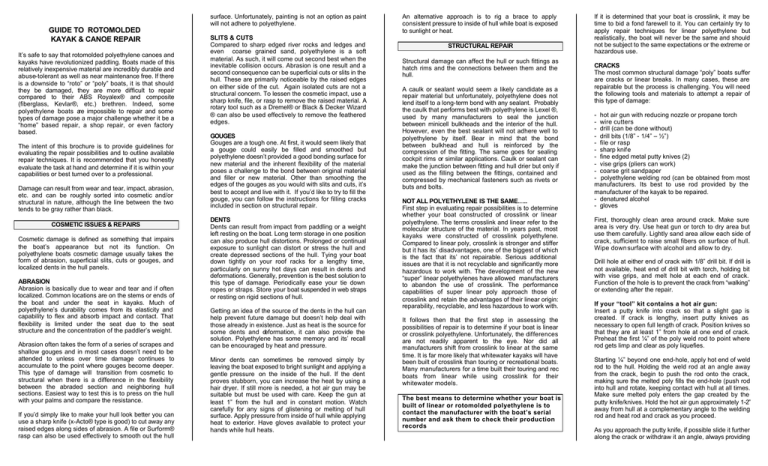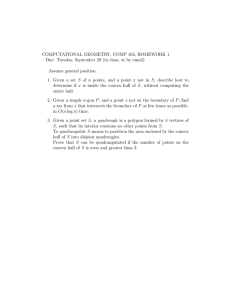Polyethylene Repair Guide
advertisement

GUIDE TO ROTOMOLDED KAYAK & CANOE REPAIR It’s safe to say that rotomolded polyethylene canoes and kayaks have revolutionized paddling. Boats made of this relatively inexpensive material are incredibly durable and abuse-tolerant as well as near maintenance free. If there is a downside to “roto” or “poly” boats, it is that should they be damaged, they are more difficult to repair compared to their ABS Royalex® and composite (fiberglass, Kevlar®, etc.) brethren. Indeed, some polyethylene boats are impossible to repair and some types of damage pose a major challenge whether it be a “home” based repair, a shop repair, or even factory based. The intent of this brochure is to provide guidelines for evaluating the repair possibilities and to outline available repair techniques. It is recommended that you honestly evaluate the task at hand and determine if it is within your capabilities or best turned over to a professional. Damage can result from wear and tear, impact, abrasion, etc. and can be roughly sorted into cosmetic and/or structural in nature, although the line between the two tends to be gray rather than black. COSMETIC ISSUES & REPAIRS Cosmetic damage is defined as something that impairs the boat’s appearance but not its function. On polyethylene boats cosmetic damage usually takes the form of abrasion, superficial slits, cuts or gouges, and localized dents in the hull panels. ABRASION Abrasion is basically due to wear and tear and if often localized. Common locations are on the stems or ends of the boat and under the seat in kayaks. Much of polyethylene’s durability comes from its elasticity and capability to flex and absorb impact and contact. That flexibility is limited under the seat due to the seat structure and the concentration of the paddler’s weight. Abrasion often takes the form of a series of scrapes and shallow gouges and in most cases doesn’t need to be attended to unless over time damage continues to accumulate to the point where gouges become deeper. This type of damage will transition from cosmetic to structural when there is a difference in the flexibility between the abraded section and neighboring hull sections. Easiest way to test this is to press on the hull with your palms and compare the resistance. If you’d simply like to make your hull look better you can use a sharp knife (x-Acto® type is good) to cut away any raised edges along sides of abrasion. A file or Surform® rasp can also be used effectively to smooth out the hull surface. Unfortunately, painting is not an option as paint will not adhere to polyethylene. SLITS & CUTS Compared to sharp edged river rocks and ledges and even coarse grained sand, polyethylene is a soft material. As such, it will come out second best when the inevitable collision occurs. Abrasion is one result and a second consequence can be superficial cuts or slits in the hull. These are primarily noticeable by the raised edges on either side of the cut. Again isolated cuts are not a structural concern. To lessen the cosmetic impact, use a sharp knife, file, or rasp to remove the raised material. A rotary tool such as a Dremel® or Black & Decker Wizard ® can also be used effectively to remove the feathered edges. GOUGES Gouges are a tough one. At first, it would seem likely that a gouge could easily be filled and smoothed but polyethylene doesn’t provided a good bonding surface for new material and the inherent flexibility of the material poses a challenge to the bond between original material and filler or new material. Other than smoothing the edges of the gouges as you would with slits and cuts, it’s best to accept and live with it. If you’d like to try to fill the gouge, you can follow the instructions for filling cracks included in section on structural repair. DENTS Dents can result from impact from paddling or a weight left resting on the boat. Long term storage in one position can also produce hull distortions. Prolonged or continual exposure to sunlight can distort or stress the hull and create depressed sections of the hull. Tying your boat down tightly on your roof racks for a lengthy time, particularly on sunny hot days can result in dents and deformations. Generally, prevention is the best solution to this type of damage. Periodically ease your tie down ropes or straps. Store your boat suspended in web straps or resting on rigid sections of hull. Getting an idea of the source of the dents in the hull can help prevent future damage but doesn’t help deal with those already in existence. Just as heat is the source for some dents and deformation, it can also provide the solution. Polyethylene has some memory and its’ recall can be encouraged by heat and pressure. Minor dents can sometimes be removed simply by leaving the boat exposed to bright sunlight and applying a gentle pressure on the inside of the hull. If the dent proves stubborn, you can increase the heat by using a hair dryer. If still more is needed, a hot air gun may be suitable but must be used with care. Keep the gun at least 1” from the hull and in constant motion. Watch carefully for any signs of glistening or melting of hull surface. Apply pressure from inside of hull while applying heat to exterior. Have gloves available to protect your hands while hull heats. An alternative approach is to rig a brace to apply consistent pressure to inside of hull while boat is exposed to sunlight or heat. STRUCTURAL REPAIR Structural damage can affect the hull or such fittings as hatch rims and the connections between them and the hull. A caulk or sealant would seem a likely candidate as a repair material but unfortunately, polyethylene does not lend itself to a long-term bond with any sealant. Probably the caulk that performs best with polyethylene is Lexel ®, used by many manufacturers to seal the junction between minicell bulkheads and the interior of the hull. However, even the best sealant will not adhere well to polyethylene by itself. Bear in mind that the bond between bulkhead and hull is reinforced by the compression of the fitting. The same goes for sealing cockpit rims or similar applications. Caulk or sealant can make the junction between fitting and hull drier but only if used as the filling between the fittings, contained and compressed by mechanical fasteners such as rivets or buts and bolts. NOT ALL POLYETHYLENE IS THE SAME….. First step in evaluating repair possibilities is to determine whether your boat constructed of crosslink or linear polyethylene. The terms crosslink and linear refer to the molecular structure of the material. In years past, most kayaks were constructed of crosslink polyethylene. Compared to linear poly, crosslink is stronger and stiffer but it has its’ disadvantages, one of the biggest of which is the fact that its’ not repairable. Serious additional issues are that it is not recyclable and significantly more hazardous to work with. The development of the new “super” linear polyethylenes have allowed manufacturers to abandon the use of crosslink. The performance capabilities of super linear poly approach those of crosslink and retain the advantages of their linear origin: reparability, recyclable, and less hazardous to work with. It follows then that the first step in assessing the possibilities of repair is to determine if your boat is linear or crosslink polyethylene. Unfortunately, the differences are not readily apparent to the eye. Nor did all manufacturers shift from crosslink to linear at the same time. It is far more likely that whitewater kayaks will have been built of crosslink than touring or recreational boats. Many manufacturers for a time built their touring and rec boats from linear while using crosslink for their whitewater models. The best means to determine whether your boat is built of linear or rotomolded polyethylene is to contact the manufacturer with the boat’s serial number and ask them to check their production records If it is determined that your boat is crosslink, it may be time to bid a fond farewell to it. You can certainly try to apply repair techniques for linear polyethylene but realistically, the boat will never be the same and should not be subject to the same expectations or the extreme or hazardous use. CRACKS The most common structural damage “poly” boats suffer are cracks or linear breaks. In many cases, these are repairable but the process is challenging. You will need the following tools and materials to attempt a repair of this type of damage: - hot air gun with reducing nozzle or propane torch - wire cutters - drill (can be done without) - drill bits (1/8” - 1/4” – ½”) - file or rasp - sharp knife - fine edged metal putty knives (2) - vise grips (pliers can work) - coarse grit sandpaper - polyethylene welding rod (can be obtained from most manufacturers. Its best to use rod provided by the manufacturer of the kayak to be repaired. - denatured alcohol - gloves First, thoroughly clean area around crack. Make sure area is very dry. Use heat gun or torch to dry area but use them carefully. Lightly sand area allow each side of crack, sufficient to raise small fibers on surface of hull. Wipe down surface with alcohol and allow to dry. Drill hole at either end of crack with 1/8” drill bit. If drill is not available, heat end of drill bit with torch, holding bit with vise grips, and melt hole at each end of crack. Function of the hole is to prevent the crack from “walking” or extending after the repair. If your “tool” kit contains a hot air gun: Insert a putty knife into crack so that a slight gap is created. If crack is lengthy, insert putty knives as necessary to open full length of crack. Position knives so that they are at least 1” from hole at one end of crack. Preheat the first ¼” of the poly weld rod to point where rod gets limp and clear as poly liquefies. Starting ¼” beyond one end-hole, apply hot end of weld rod to the hull. Holding the weld rod at an angle away from the crack, begin to push the rod onto the crack, making sure the melted poly fills the end-hole (push rod into hull and rotate, keeping contact with hull at all times. Make sure melted poly enters the gap created by the putty knife/knives. Hold the hot air gun approximately 1-2” away from hull at a complementary angle to the welding rod and heat rod and crack as you proceed. As you approach the putty knife, if possible slide it further along the crack or withdraw it an angle, always providing a slight gap to allow melded poly to enter. Make sure to apply enough poly so that a slight bead is left on the surface. Continue applying weld rod to crack, removing the putty knife(s) as required. Crack should close as you remove spacers. Make sure that the applied poly from the rod is still hot and liquid as the crack closes behind the point at which you are working. At end-hole opposite of where yu started, melt enough rod to overfill hole (insert rod into hole and rotate rod. Make sure you keep end of rod in contact with hull as you push it down into hull and pull it out. Apply rod to hull approximately ¼” beyond hole. Do not pull the rod away as you finish as this may pull some of the applied poly with it. Cut unmelted rod with w ire cutters or crimps. Smooth out the bead of poly sitting on top of crack, using gloved hands. Judiciously heat bead with hot air gun and press and smooth with hands if you want a smoother surface. Allow hull to cool completely before moving or disturbing. Test the quality of bond by pushing corner point of putty knife under edge of applied polyethylene and prying up. If bead lifts easily or bead rises down along the crack, you have not achieved a good quality repair. Alternative method using Propane Torch A torch with open flame is fine for generating heat necessary to conduct repair but it is not recommended to melt the weld rod poly directly with a torch. Use a drill bit as described to melt the rod. Drill end-holes at end of crack as described above. Insert putty knives as described to slightly open crack (no more than 1/16”). Clamp drill bit in vise grips so that shank or smooth end of bit extends from jaws of vise grip. Heat end of bit until it glows red hot. Apply end of bit to crack in hull and heat the plastic until it begins to melt. Rolling the bit or working in a circular motion is effective. Holding the poly weld rod against hot bit, melt end of rod and drip onto crack in hull. Alternate heating rod and hull surface to keep both hot. It will be necessary to periodically reheat the drill bit to keep it hot enough to do its’ job. Proceed along the length of the crack, removing putty knife spacers as required. Slightly overfill the end holes and make sure the filler poly from the weld rod bonds well to edges of holes. Once crack and end-holes have been filled, cut end of weld rod with wire cutters. Pass the torch quickly over the repair several times until the repair poly glistens slightly and then smooth with gloved hands. Do not allow flame on torch to contact hull and keep torch moving at all times. Severe hull damage can result from excess exposure to flame or excess heat. Allow hull to cool completely before moving. Test quality of bond as described previously. SMALL HOLES Repair of small punctures is similar to filling the end-holes on cracks. For tiny holes, it may be necessary to slightly enlarge the hole first to allow the melted poly to enter and seal the hole. You can enlarge the hole by drilling with small bit or by heating drill bit and melting hole slightly. For best results, heat area around the hole and apply the melted poly from the weld rod to surface while hull is hot. This allows repair poly to bond with hull material as repair cures. Press melted end of poly rod against hole and rotate rod in hole to spread adequate repair material in place. Cut off unmelted part of poly rod. Do not try to pull rod away as this could pull melted poly from hole. LARGE HOLES It is possible to weld a patch to your hull but can be a tricky process. As its necessary to melt your existing hull surface at point of repair, the possibility of inadvertently further damaging your hull does exist. If possible, rehearse the process on a couple of scrap pieces of polyethylene before attempting on our boat. For best results, obtain a patch of adequate size from your boat’s manufacturer. A hot air gun is preferable to an open flame torch for this repair. Cut the patch so that it is slightly oversized compared to the hole. The patch material can be cut with large wire cutters, jigsaw, or circular saw. Shape the patch so that it is rounded to eliminate sharp edges or corners that could lift if struck by an obstruction. Heat patch until it becomes slightly pliable. With gloved hands hold it in place over area to be patched until it cools and holds a matching contour to that section of hull. Sand the hull surface to be covered with the patch to raise a texture and small feathers of material. Wipe clean with denatured alcohol and let dry. Take weld rod and melt a bead of polyethylene in a circle around the hole in hull. Heat the area to be patched until hull surface softens slightly, alternately heating underside of patch as well so that both attain temperature at about the same time. Make sure that bead surrounding the hole is soft and melted. While all surfaces are hot, press patch onto hull and hold in place. Take weld rod and melt a bed along exterior edge of patch, melding patch and hull into one piece. Using gloved finger or flat tipped screwdriver shape bead of polyethylene from weld rod so that it smoothes transition from original hull to patch, eliminating sharp edges. Allow patched area to fully cool before moving or disturbing. An alternative to melting a patch and possibility of damaging the hull It is possible to mechanically attach a patch to your hull. Cosmetically, it won’t look as nice but it can make your boat serviceable again. The process involves riveting a patch in place. To perform this repair you will need the following: - patch - drill with bit sized appropriately for rivets selected - sufficient rivets to secure patch, spaced about 1” apart along circumference of patch. Length of rivets should be just long enough to secure the patch and hull material. Longer rivets can create sharp edges on interior of hull that can pose a danger to you or your gear. - rivet gun - tube of Lexel ® or comparable sealant - duct tape Obtain a patch approximately 2” larger in all dimensions than the hole. If possible, cut edge of patch at an angle to produce a softer edge. You might want shape edge with rasp or file or grinder to angled edge. For best results, heat patch to pliable and hold it against hull to conform to hull shape. If you don’t have a heat gun, you can place patch in hot water and heat until it becomes pliable. Once patch is conformed, apply a bead of sealant around hole. Apply a second bead to patch, approximately ¾” inside outer edge. Apply patch to hull and tape in place with duct tape. Mark and drill holes for rivets within ½” of edge of patch, spacing holes no further than 1” apart. Press firmly on the patch next to hole to be riveted. Insert rivet in gun, place shank in hole and install. For best results, if rivet does not snap at first pull, release trigger and push head of rivet gun firmly against patch and pull trigger again. The integrity and dryness of this repair process is entirely dependant the tightest possible seal between patch and hull. A tight seal will compress the sealant placed between the patch and hull. Allow repair to fully cure as indicated by manufacturer’s instructions on tube of sealant. If you’d like to maximize the dryness of the seal, melt a bead of polyethylene from a weld rod along the junction of patch and hull. Shape with angled straight edge to provide smooth transition between patch and hull.




